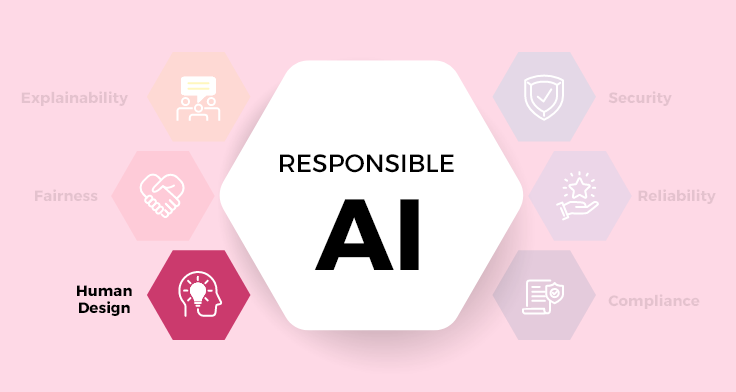Artificial Intelligence (AI), while ushering in an age of unprecedented possibilities, also presents significant ethical challenges that warrant thoughtful consideration. With astounding rapidity, AI is upending the conventional demarcation between human and machine. Acknowledging this, the responsible AI framework underscores the imperative of consciously integrating the human element within the algorithmic fabric. Central to this conversation are four key dimensions: human involvement in the AI decision-making process, user feedback optimization, ethical implications, and informed consent.
-
The Human Touch: Involvement in Decision Making
AI systems are designed to learn, predict, and autonomously execute decisions. However, should they be given unbridled liberty to make decisions in critical situations without human intervention?
The ‘human-in-the-loop’ model posits that human oversight is necessary for certain AI functions—especially those with significant consequences. By keeping humans involved, we safeguard the decision-making process from autonomous AI decisions that lack ethical considerations or context understanding. For instance, in an automated traffic management system, a human in the loop could override the system in extraordinary circumstances, preventing unfavorable outcomes that a rigid algorithm may not foresee.
-
Refining the AI Lens: Incorporating User Feedback
The true strength of AI lies in its iterative ability to learn and improve—an approach perfected when combined with user feedback. User feedback is akin to the potter’s hands that shape the clay of AI algorithms—directing their evolution and improving their adaptability.
Consider Netflix’s recommendation algorithm. By incorporating viewer feedback in the form of ratings, watched history, and paused or skipped content, Netflix refines its algorithm to offer increasingly personalized recommendations. Such practical incorporation of user feedback refines the AI’s functionality, aligning it closely with user preferences and needs.
-
The Ethical Compass: Navigating AI
While AI unleashes enormous potential, it continues to grapple with unresolved ethical quandaries. Recurrent concerns of bias, discrimination, and privacy threats refuse to be relegated to the sidelines.
The principle of fairness necessitates that the AI system remains free from biases and provides equitable opportunities for all. However, unintended algorithmic biases can have deleterious effects. For example, an AI system used in legal sentencing showed racial bias in its predictions. Addressing these issues requires conscious efforts to ensure fairness in AI design by employing diverse, balanced datasets and utilizing debiasing techniques.
Transparency is another ethical pillar—it demands lucid explanations of how AI systems operate, decide, and learn. Finally, the integrity of AI systems hinges on respecting privacy—using only essential, consensual data and upholding robust data protection norms.
-
Informed Consent: Empowering Users
Informed consent is the backbone of any user-oriented technology—a principle just as crucial in the context of AI.
Informed consent ensures that users understand the risks, are educated about AI’s capacities and constraints, and freely decide to use AI systems. For instance, if a predictive health analytics platform uses personal health data to predict disease risk, it is vital that users understand this algorithm’s implications. They should be given explicit information regarding data usage, storage, protection measures, and the underlying algorithm’s predictive accuracy.
Achieving informed consent involves drafting transparent user agreements, soliciting active user participation, and enabling controls for users to manage their interaction with the AI system. Such steps engender a sense of trust and empowerment among users, turning them from passive recipients to active collaborators.
Navigating the AI Age Responsibly
When implemented conscientiously, a responsible AI framework has the potent potential to harmonize AI’s relentless efficiency with the nuanced understanding of human decision makers. A judicious blend of algorithmic learning and human intuition can greatly enhance the quality and acceptability of AI decisions, translating into wider user acceptance and adoption.
Moreover, analyzing AI’s ethical implications allows us to bridle potential pitfalls, ensuring that algorithms are fair, transparent, and responsible by design. Coupled with informed consent, such ethical practices empower users, enabling them to navigate the AI landscape confidently.
In sum, the human design component—the symbiotic interplay of human oversight, user feedback, ethical standards, and user consent—resides at the heart of responsible AI systems. By consciously weaving this component into AI algorithms, we can ensure that as we stride forward in our AI journey, we don’t lose touch with the core human values that dictate progress in an equitable, understandable, and responsible manner.
Artificial Intelligence (AI), while ushering in an age of unprecedented possibilities, also presents significant ethical challenges that warrant thoughtful consideration. With astounding rapidity, AI is upending the conventional demarcation between human and machine. Acknowledging this, the responsible AI framework underscores the imperative of consciously integrating the human element within the algorithmic fabric. Central to this conversation are four key dimensions: human involvement in the AI decision-making process, user feedback optimization, ethical implications, and informed consent.
To explore the other parts in this series, click here.
Recent Blogs

LLMs – Self-Hosting or APIs? The Million Dollar Question
April 16, 2025

Fashion Retail in the Age of AI: Redefining Design and Customer Experience with Data & Intelligence
April 11, 2025

Navigating the Tariff Shock: How AI and Advanced Analytics Fuel Supply Chain Resilience
April 7, 2025

From Data to Decisions: The Evolving Role of Data Science & AI in Supply Chain
March 20, 2025


